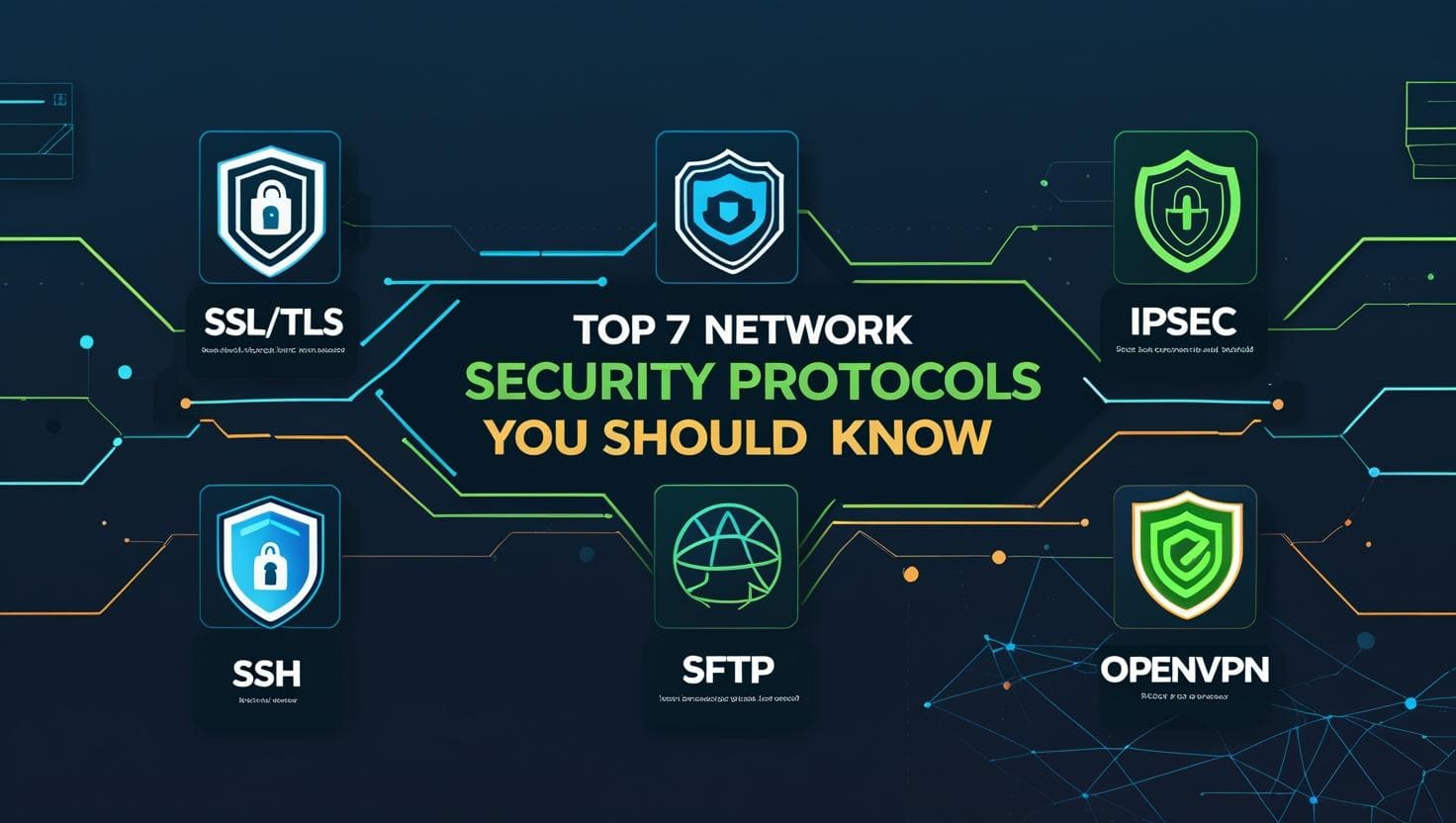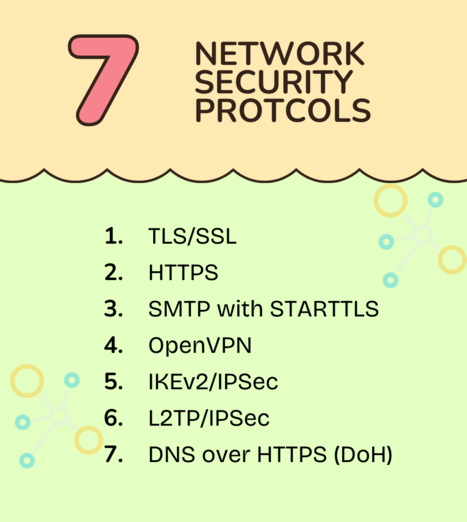
Internet Security Protocols provide the backbone of safe online communication, playing a key role in protecting sensitive information from unauthorized access, manipulation, and theft.
Companies with outdated security protocols face 2.5x times higher breach costs than those with modernized systems.
The goal of this article is to help you understand network security protocols and inform you about the top 7 network security protocols you should know in 2025. You can also learn more about these internet security protocols in our Online Network Security Courses.
What is Network Security Protocol?
A network security protocol is a collection of guidelines that protects the two aspects of the CIA triad -confidentiality and integrity of the data being transferred across a network. These protocols guard your data against cyber threats like unwanted access, manipulation, and destruction.
Internet security protocols use encryption to keep data safe. They often combine block ciphers and session keys, which are securely shared using public-key methods, so there's no need for pre-shared passwords, hence ensuring the confidentiality and integrity of data.
While these network security protocols prevent data from being stolen or changed, it doesn’t guarantee that services will always be available. To ensure data availability, we can use other security tools like firewalls, traffic filters, and monitoring systems.

Types of Internet Security Protocols
There are four types of internet security protocols:
1. Access Control Protocols: These protocols verify user identities to ensure that only authorized users can access certain resources. For example, Kerberos and OAuth.
2. Encryption Protocols: These protocols protect data by converting it into a secure format that can only be read by authorized parties. For example, TLS/SSL and IPsec.
3. Key Management Protocols: These protocols manage encryption keys to ensure they are stored and distributed securely. For example, Public Key Infrastructure (PKI) and Diffie-Hellman.
4. Message Integrity Protocols: These protocols ensure that messages are not tampered with during transmission. For example, HMAC (Hash-Based Message Authentication Code) and Digital Signatures.

Top 7 Network Security Protocols
Network security protocols are critical for protecting online activities such as web browsing, emailing, and virtual private network (VPN) usage. Below is a list of the 7 most important internet security protocols.
1. TLS/SSL (Transport Layer Security / Secure Sockets Layer)
TLS and its predecessor, SSL, are cryptographic protocols designed to provide secure communication over a computer network. They are most commonly used in web browsers and applications that require data to be securely exchanged over the internet.
TLS ensures confidentiality by encrypting data, integrity by hashing messages to prevent tampering, and authentication through digital certificates that verify the identities of parties involved. SSL is now deprecated in favor of TLS due to security vulnerabilities.
Read About Data Encryption
2. HTTPS (Hypertext Transfer Protocol Secure)
HTTPS is an extension of HTTP that uses TLS to encrypt the data transmitted between a user's browser and the web server. It helps protect sensitive information like passwords, payment details, and personal data from eavesdropping or interception.
HTTPS ensures encryption to protect data from man-in-the-middle attacks, server authentication to verify that the website is legitimate, and data integrity to prevent content from being modified in transit.
3. SMTP with STARTTLS (Simple Mail Transfer Protocol + STARTTLS Extension)
SMTP is the standard protocol for sending emails, and STARTTLS is an extension that upgrades a plain-text connection to an encrypted one using TLS. It enhances the security of email transmission by encrypting messages between mail servers.
STARTTLS prevents eavesdropping by encrypting email content during transit, offers backward compatibility by falling back to plain SMTP if encryption isn't supported (though this is discouraged), and authenticates mail servers to help prevent spoofing and email tampering.
4. OpenVPN
OpenVPN is an open-source VPN protocol that uses SSL/TLS for key exchange and can encrypt data using up to 256-bit encryption standards. It supports a wide range of encryption algorithms and is known for its flexibility and robust security.
OpenVPN is highly configurable, can operate over TCP or UDP ports, uses the OpenSSL library to support various cryptographic algorithms, and offers authentication options including pre-shared keys, username/password, or certificates.
Read About TCP Ports
5. IKEv2/IPSec (Internet Key Exchange Version 2)
IKEv2 is a tunneling protocol often paired with IPSec to create secure VPN connections. It establishes and maintains security associations and supports mobility and multi-homing features.
IKEv2 is fast and stable, quickly reconnecting when internet connections drop, provides security through mutual authentication and high encryption levels, and supports mobility, making it ideal for mobile users switching between networks.
6. L2TP/IPSec (Layer 2 Tunneling Protocol + Internet Protocol Security)
L2TP by itself does not provide encryption but is often combined with IPSec to add a layer of security. IPSec handles the encryption and authentication, making L2TP/IPSec a strong VPN solution.
L2TP encapsulates the data, while IPSec encrypts it, adding an extra layer of security through double encapsulation, and is widely supported, being built into most modern operating systems.
7. DNS over HTTPS (DoH)
DNS over HTTPS encrypts DNS queries by sending them over HTTPS, preventing third parties from viewing what websites a user is trying to access. It protects against DNS spoofing by ensuring the authenticity of DNS responses.
It also improves privacy by preventing ISPs and other intermediaries from logging DNS queries, and it works over port 443, making it difficult to block. DoH is integrated into modern web browsers like Firefox and Chrome to enhance user privacy and security on the internet.
Learn about Domain Name System(DNS)
Advantages of Network Security Protocols
Security protocols offer several benefits:
● Ensures only authorized users can access data.
● Prevents unauthorized alterations during transmission.
● Confirms user or device identity.
● Prevents denial of actions performed.
● Boosts user and client confidence in secure systems.
Challenges for Implementing Security Protocols
The table below summarizes the challenges and solutions of implementing network security protocols:
| Challenge | Corresponding Best Practice |
|---|---|
| Complexity in configuration | Implement layered security strategies (defense in depth) |
| Compatibility with legacy systems | Use strong, up-to-date encryption standards |
| Human error and misconfiguration | Train staff in protocol use and security awareness |
| Outdated or unpatched systems | Regularly update and patch systems |
| Undetected vulnerabilities | Conduct security audits and penetration testing |
Future of Network Security Protocols in the Next Decades
The future of network security protocols is evolving to meet emerging threats and technological advancements. Some of the emerging technologies that are making current internet security protocols more secure are:
1. Quantum-resistant cryptographic protocols: These protocols will ensure data security from the powerful decryption capabilities of future quantum computers.
2. Zero Trust-based protocols: It will enforce continuous identity verification and minimize trust assumptions across network layers.
3. End-to-end encryption: More communication protocols are coming with end-to-end encryption to enhance the privacy of IoT and mobile networks.
4. Blockchain-based authentication protocols: These protocols offer decentralized and tamper-proof identity verification. Unlike traditional systems that rely on centralized servers, blockchain stores identity data across a distributed ledger, making it extremely difficult to alter or compromise.
Conclusion
Security protocols are indispensable tools in defending digital assets against a growing array of cyber threats. From securing online transactions to protecting enterprise networks, these protocols ensure that data remains confidential, authentic, and tamper-proof.
As technology advances, organizations must continuously adapt, update, and innovate their security protocols to stay ahead of evolving threats in the dynamic landscape of cybersecurity.

Amar Singh is a senior security architect and a certified trainer. He is currently working with a reputed organization based out of India. His accomplishments include CCNA, CCNP Security, CEH, Vmware, Checkpoint and Palo Alto Certifications. He is holding more than 12 years of experience in Network security domain. In his career he has been ...
More... | Author`s Bog | Book a MeetingFAQ
Comments (0)
Popular posts


Different Types of Network Topologies ...
25 Aug 2025
CCNA Exam Fees and Expenses Breakdown
25 Aug 2025
New Cisco CCNA Syllabus for 2025
25 Aug 2025
Top 12 Cloud Service Providers Globally ...
29 Aug 2025Recent posts

What is Cisco NSO and What is It Used ...
22 Oct 2025
Understanding BGP AD Value in Networking
22 Oct 2025
Best Network Simulation Tools for ...
8 Oct 2025.jpg)
What is NAT in Networking and How it ...
6 Oct 2025
Top 20 CI/CD Tools For Easy Development ...
1 Oct 2025Upcoming batches
Contact learning advisor


.png)







